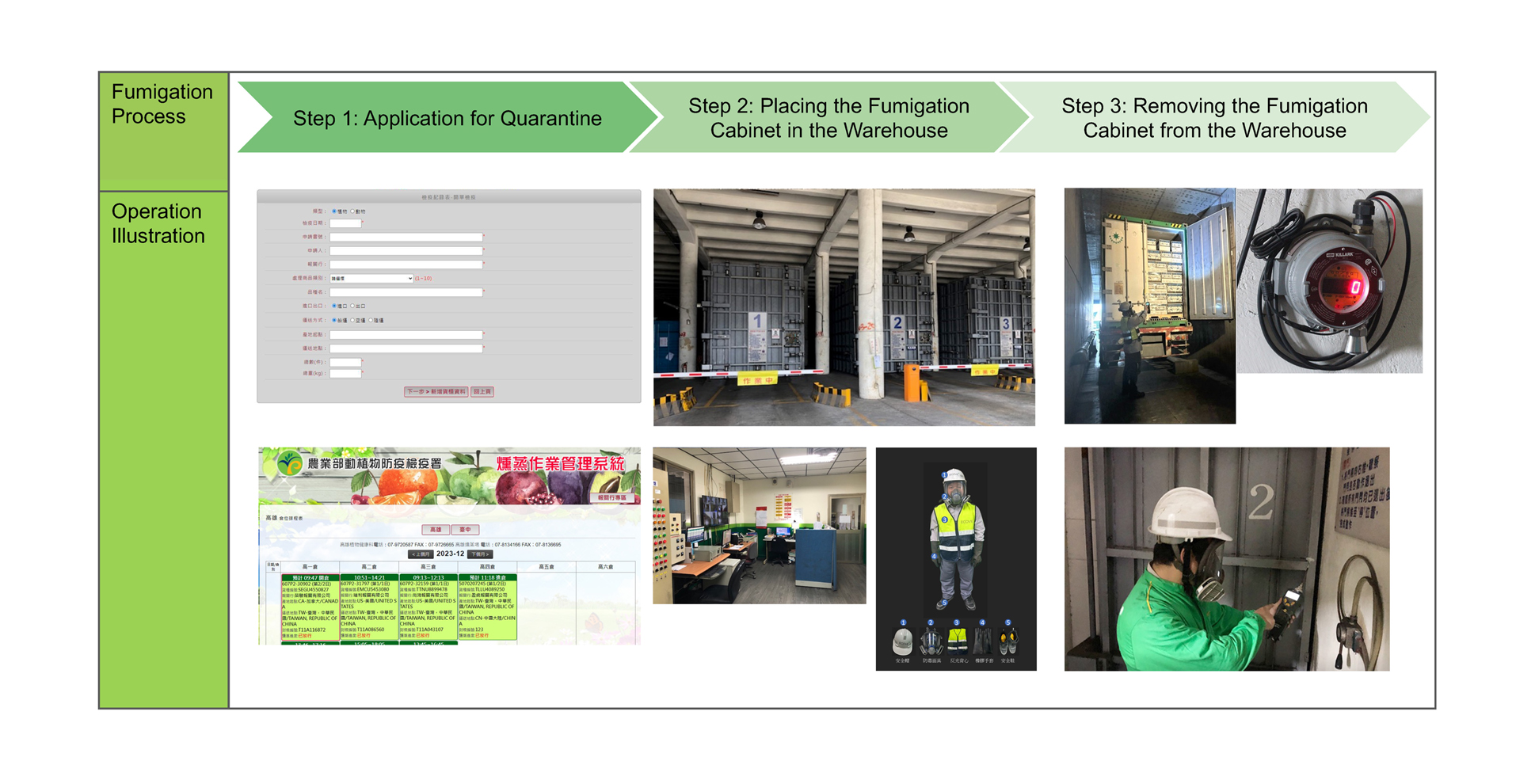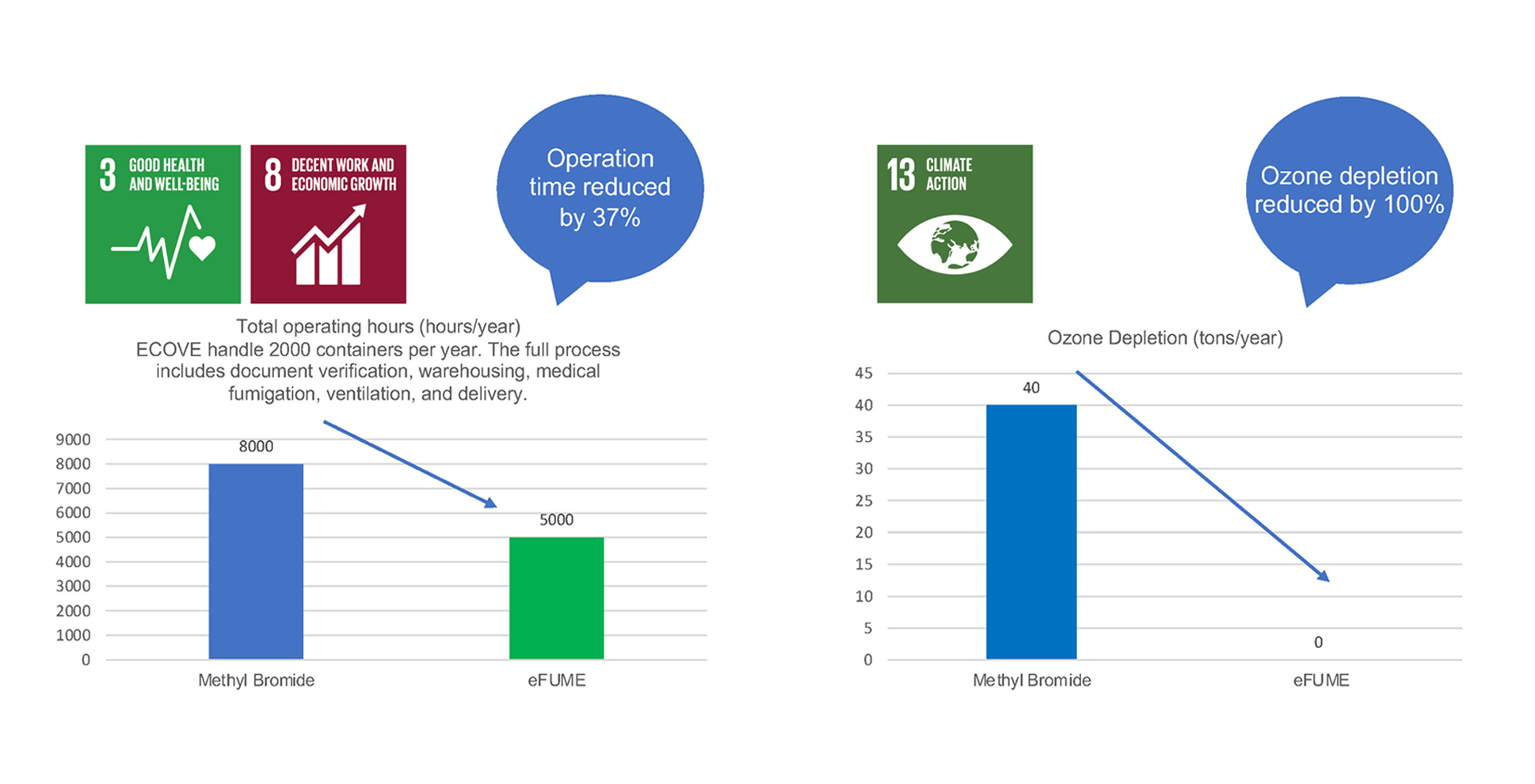Eco-friendly Innovation
綠色創新
Protecting the Ozone Layer Together- Replacing Methyl Bromide with eFUME™ as a Quarantine Fumigant
Ecove, a subsidiary of the Chinatrust Group, has been actively engaged in the field of circular economy. Since 2015, it has been assisting the government in quarantine efforts to protect agricultural resources and ensure food safety. In 2024, ECOVE took proactive measures to address the growing concern for environmental protection by proposing to replace the environmentally harmful fumigant, methyl bromide, with eco-friendly alternative: eFUME™. This proposal was widely acknowledged and appreciated by clients. This article outlines how ECOVE responds to and implements the global environmental protection trend.
Legal Yet Controversial: Methyl Bromide that Goes Against the Global Environmental Awareness
Methyl bromide (CH₃Br), a colorless and odorless gas, has been available on the market since the 1930s. It has become the predominant fumigant used legally for quarantine and pre-shipment (QPS) purposes in various countries due several advantages: its powerful penetration, effective termination of pests without damaging packaging, while being able to save time and cost. However, the release and emission of methyl bromide during the fumigation process react with ozone molecules in the atmosphere, leading to ozone layer depletion. It is one of the Ozone Depleting Substances (ODS) that contribute to the destruction of the ozone layer. Therefore, countries around the world have followed the provisions of the Montreal Protocol adopted by the United Nations Environment Programme (UNEP) has been gradually reducing the production and use of methyl bromide since 1995. However, due to the Critical Use Exemption (CUE) factors related to the lack of alternatives and the critical applications of alternative technologies, production and distribution of methyl bromide continued worldwide. It remains an invisible threat to the ozone layer to this day. Recognizing the importance of the ozone layer to the ecological environment, the European Union has already banned the use of Methyl Bromide. In Taiwan, imported methyl bromide has been restricted only for QPS use.
The Health Risks Associated with the Use of Methyl Bromide
While methyl bromide is solely used for QPS purposes, there remains a potential health risk for on-site quarantine fumigation operators. Inhaling low doses (5 ppm) of methyl bromide for a short period does not immediately cause respiratory irritation. Most symptoms can fully recover without complications. However, exposure to high doses (500 ppm) of methyl bromide for a short period can result in severe and irreversible complications in the nervous and respiratory systems, including brain lesions, peripheral neuropathy, respiratory irritation, pulmonary edema, with possible liver and kidney damage.
QPS Substitute Agent with Zero Ozone Depletion Potential - eFUME™
In order to comply with international conventions, environmental trends, and to protect operational personnel from exposure to methyl bromide hazards, ECOVE recommended the use of the QPS alternative pesticide eFUME™, which has zero ozone-depleting potential, in a container quarantine fumigation project commissioned by the Animal and Plant Quarantine Bureau of the Council of Agriculture, Executive Yuan. The project was managed by a private company (now under the jurisdiction of the Animal and Plant Quarantine Bureau of the Ministry of Agriculture).With the support and recognition of the Ministry of Agriculture and the Ministry of Environment, the pesticide and related evaporation equipment were imported for fumigation testing at the Kaohsiung Port Quarantine Processing Center. The on-site implementation process and testing effectiveness were evaluated to establish Standard Operating Procedures. According to technical data disclosed by Draslovka Services Group (Melbourne, Australia), (https://www.draslovka-services.com/wp-content/uploads/2022/01/eFUME-flyer_Final_2021.pdf) the eFUME™ formulation consists of 16.7% ethyl formate (C3H6O2) and 83.3% carbon dioxide. It is stored in liquid form in pressurized tanks. Ethyl formate has been designated as generally regarded as safe (GRAS) by the American Food and Drug Administration (FDA). It exhibits low toxicity to mammals and does not deplete ozone. Because of its ability to rapidly kill pests, it has been approved for use in QPS applications by many countries.
eFUME™: Test Results and Benefits of Fumigation
The fumigation test was conducted by a third-party academic institution commissioned by the Animal and Plant Health Inspection Agency of the Ministry of Agriculture(APHIA). The test took place at the bulk fumigation warehouse of the Kaohsiung Port Quarantine Center, which falls under the jurisdiction of APHIA’s Kaohsiung Branch. It consisted of two parts: a gas tightness test for the empty warehouse and an insecticidal test for fumigating fruits and vegetables. The fumigation process utilized the eFUME™ chemicals. The air tightness test for the empty chamber was conducted to confirm the air tightness of the experimental chamber. The results of the experiment showed that the concentration of the fumigant inside the chamber can be maintained during the fumigation process, indicating that the air tightness of the fumigation chamber as normal. Furthermore, a fumigation insecticidal test was conducted in an experimental chamber with regular air tightness level. Specific amounts of pests were inoculated onto vegetables and fruits for practical observation. Following the recommended optimal fumigation dosage and exposure time from the original eFUME™ technical manual, three repeated tests were conducted. The results also indicated a 100% mortality rate of the inoculated pests on the fruits and vegetables, demonstrating that the insecticidal effect of eFUME™ fumigation is comparable to that of methyl bromide. The preliminary findings meet the quarantine usage requirements of the client. A detailed explanation of the test implementation process is shown in the diagram below.

eFUME™ Test Process Diagram
Based on statistical data from the Kaohsiung Port Quarantine Processing Center for the years 2019 through 2023, the Project Team assists owners in fumigating an average of approximately 2,000 containers per year during quarantine. Based on the test results mentioned above, replacing methyl bromide with eFUME™ (16.7% ethyl formate, 83.3% CO₂) can achieve the same insecticidal effect. Moreover, due to its low toxicity to humans, it can reduce over 50% fumigation and exhaust operation time. As a result, it indirectly enhances the quarantine capacity of the business's equipment. Substituting methyl bromide with eFUME™ offers tangible advantages, including lower toxicity, zero ozone depletion potential, improved fumigation efficiency, and enhanced environmental safety.

Fumigation Operation Process Flowchart

Diagram of eFUME™ Fumigation Time and Environmental Safety
ECOVE Fully Embraces and Adheres to the Global Trend of Environmental Protection
Looking forward, ECOVE envisions itself as “the most reliable leader in sustainable resource recycling.” With a mission committed to “advancing technology integration” and “optimizing resource recycling efficiency.” The company is committed to unwavering dedication to sustainable operations. It pledges to leverage core competencies and fulfill corporate social responsibilities. Since 2015, ECOVE has successively acquired projects such as the “Commissioned Operation and Management of the Animal and Plant Quarantine Treatment Center, Kaohsiung Branch, Bureau of Animal and Plant Health Inspection and Quarantine, Council of Agriculture, Executive Yuan” and the “Commissioned Operation of the Quarantine Treatment Plant in Taichung Harbor.” Throughout the execution of these projects, the company actively incorporated environmentally friendly measures, enhanced operational efficiency, utilized smart systems, and employed data analysis to establish a safe and healthy workplace, while ensuring the safety of on-site personnel. Recently, ECOVE has recommended clients the patented fumigant eFUME™, which has zero ozone-depleting potential. After obtaining approval for the project, the company imported the fumigant, established standard operating procedures, and conducted equipment construction and trial runs. The effectiveness of the fumigant was verified through testing, and the new fumigant is expected to be implemented in on-site fumigation quarantine operations in the fourth quarter of 2024. ECOVE is committed to protecting the Earth’s ozone layer and minimizing environmental impact. Quarantine work serves as the primary defense in safeguarding the nation’s agricultural resources and ensuring food safety. As a reputable player in resource recycling, ECOVE is dedicated to fulfilling its social responsibility as a responsible corporate citizen. Moving forward, ECOVE will continue to leverage its expertise in quarantine-related projects to ensure the safety of national agricultural production, promote the development of a sustainable ecological environment, safeguard the food safety of the population, and protect the health of the Taiwanese people.




